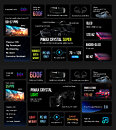TheLostSwede
News Editor
- Joined
- Nov 11, 2004
- Messages
- 18,908 (2.50/day)
- Location
- Sweden
| System Name | Overlord Mk MLI |
|---|---|
| Processor | AMD Ryzen 7 7800X3D |
| Motherboard | Gigabyte X670E Aorus Master |
| Cooling | Noctua NH-D15 SE with offsets |
| Memory | 32GB Team T-Create Expert DDR5 6000 MHz @ CL30-34-34-68 |
| Video Card(s) | Gainward GeForce RTX 4080 Phantom GS |
| Storage | 1TB Solidigm P44 Pro, 2 TB Corsair MP600 Pro, 2TB Kingston KC3000 |
| Display(s) | Acer XV272K LVbmiipruzx 4K@160Hz |
| Case | Fractal Design Torrent Compact |
| Audio Device(s) | Corsair Virtuoso SE |
| Power Supply | be quiet! Pure Power 12 M 850 W |
| Mouse | Logitech G502 Lightspeed |
| Keyboard | Corsair K70 Max |
| Software | Windows 10 Pro |
| Benchmark Scores | https://valid.x86.fr/yfsd9w |
Pimax, a leading innovator in the Virtual Reality industry, announced two new high-end VR headsets at its Frontier 2024 event, held on YouTube this Monday. The Crystal Super is an ultra-high-end headset, packing 29.5 million pixels and the world's first changeable optical engine, allowing users to swap between QLED and micro-OLED panels. The Crystal Light offers the same 16.6 million pixels as the Pimax Crystal, but is much more budget-friendly, starting from 699 USD. Additionally, Pimax unveiled the 60G Airlink module, which leverages WiGig technology to enable true high-fidelity wireless PCVR.
The Crystal Super represents a substantial leap forward from the highly successful Crystal, with its greatly increased number of pixels, enabling a much larger field of view (FOV) and higher pixels per degree (PPD) simultaneously.



Besides FOV and PPD, the choice of displays plays a critical role in user experience. QLED and micro-OLED each offers distinct advantages, and Crystal Super allows users to choose between the two or opt for both. This flexibility stems from the world's first replaceable optical engine system invented by Pimax, which combines the displays and lenses as a single detachable module.
Pimax Crystal Super starts from 1799 USD (excluding VAT), and ready for shipping in Q4.
The Crystal Light serves as a streamlined iteration of the Pimax Crystal, retaining the core specifications that underpinned the Crystal's success while removing features less essential to PCVR. Such adjustments have significantly reduced costs and also decreased the weight by 30%. This enables Pimax to position the Crystal Light at a starting price of 699 USD, offering unmatched value in its category.
The Crystal Light is available for pre-order now and shipping in May.
Pimax also clarified that they will continue to evolve the Pimax Crystal, which has been designed from the start as a high-end wireless PCVR headset. This requires extremely broad bandwidth and highly efficient utilization, necessitating the XR2 chip and battery, which have been integral parts of the Crystal.
An extra set of hardware, the 60G Airlink from Pimax, is introduced to complete the wireless solution. Utilizing Wigig technology, Pimax's 60G Airlink offers significantly higher bandwidth than conventional WiFi.
The 60G Airlink is priced at 299 USD, ready for shipping later this year.
View at TechPowerUp Main Site | Source
The Crystal Super represents a substantial leap forward from the highly successful Crystal, with its greatly increased number of pixels, enabling a much larger field of view (FOV) and higher pixels per degree (PPD) simultaneously.



Besides FOV and PPD, the choice of displays plays a critical role in user experience. QLED and micro-OLED each offers distinct advantages, and Crystal Super allows users to choose between the two or opt for both. This flexibility stems from the world's first replaceable optical engine system invented by Pimax, which combines the displays and lenses as a single detachable module.
Pimax Crystal Super starts from 1799 USD (excluding VAT), and ready for shipping in Q4.
The Crystal Light serves as a streamlined iteration of the Pimax Crystal, retaining the core specifications that underpinned the Crystal's success while removing features less essential to PCVR. Such adjustments have significantly reduced costs and also decreased the weight by 30%. This enables Pimax to position the Crystal Light at a starting price of 699 USD, offering unmatched value in its category.
The Crystal Light is available for pre-order now and shipping in May.
Pimax also clarified that they will continue to evolve the Pimax Crystal, which has been designed from the start as a high-end wireless PCVR headset. This requires extremely broad bandwidth and highly efficient utilization, necessitating the XR2 chip and battery, which have been integral parts of the Crystal.
An extra set of hardware, the 60G Airlink from Pimax, is introduced to complete the wireless solution. Utilizing Wigig technology, Pimax's 60G Airlink offers significantly higher bandwidth than conventional WiFi.
The 60G Airlink is priced at 299 USD, ready for shipping later this year.
View at TechPowerUp Main Site | Source





